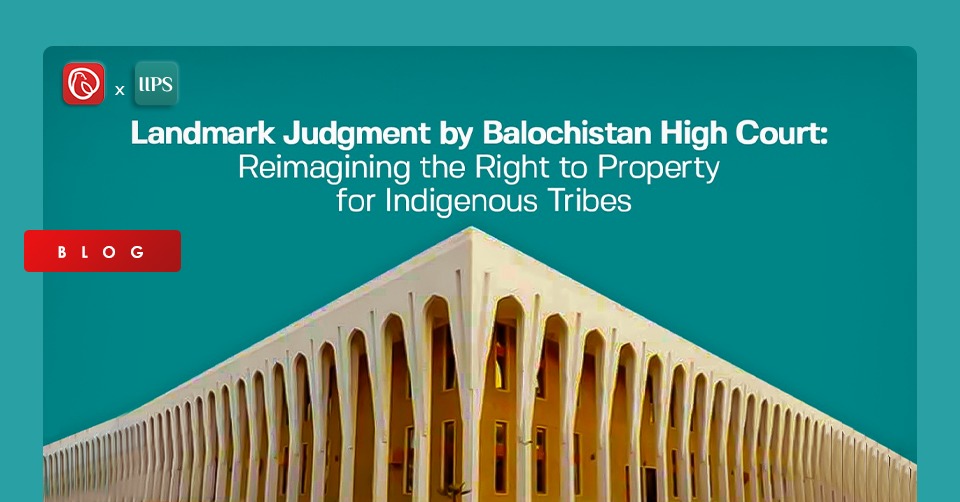Introduction
The right to property is a fundamental right enumerated in the constitution of Pakistan. Fundamental rights are essentially the inalienable natural rights which protect the freedom and liberties of the people from the government as they are universal human rights bestowed upon by nature. Property rights, albeit land rights, play a crucial role in the social, economic, and cultural growth of a country. These rights stem from culture, and contribute to the economic growth of the nation as a whole, thus forming an indispensable component of the financial ecosystem. From its conception in Lockean Rights to the contemporary ‘bundle of rights theory, the notion of property has evolved over time. Since property rights establish and regulate the social and economic relationships amongst communities, individuals, and the state, courts have a crucial role to play in interpreting new conceptions of property rights. This is particularly relevant to the context of Pakistan, where a landmark ruling by the Balochistan High Court declared indigenous tribes to be the owners of vast trenches of ‘unsettled land’, as opposed to the contesting provincial government, hence reimagining the right to property entrenched in the constitution of Pakistan.
This blog by the Iqbal Institute of Policy Studies will discuss the rights of property in Pakistan, the impact of the landmark Balochistan High Court Judgment on the rights of indigenous tribes, and the global influence of the said judgment in detail.
Right to Property Within the Purview of the Constitution of Pakistan
The constitution of the Islamic Republic of Pakistan has detailed the rights of property within the ambit of Articles 23, 24, 172, and 173. These provisions further regulate the different statutes on the rights of property, including transfer and ownership of immovable property, the registration of the immovable property, taxes and levies, and possession of property etc.
Article 23 and Article 24 are enshrined as fundamental rights in the constitution of Pakistan. The former allows citizen(s) to acquire, hold or dispose of property whereas the latter protects the rights of property in accordance with the laws of Pakistan (Article 23, Article 24).
Article 172 sets out the law for ‘ownerless property’, thereby vesting the interests of the said property in the provincial and federal government, in absence of a rightful owner. This includes the continental shelf, territorial waters, and natural resources including mineral oil and natural gas (Article 172).
Article 173 extends the executive authority of the federation and the province(s) to acquire, sell, purchase property, and to enter into contracts on behalf of the government (Article 173).
Impact of Judgement of the Rights of Indigenous Tribes
Balochistan, being the largest province of Pakistan in terms of area, constitutes over 43% of the total landmass of the country. Given the unique geographical landscape of the region, more than 90% of the total land is ‘unsettled’, meaning the land is not documented in land records, and the provincial government becomes a contender for ‘ownerless property’ within the ambit of Article 172 of the constitution.
Two constitutional petitions, C.P. 1128/2020 and C.P. 1269/2018 were moved in the Balochistan High Court by a number of petitioners, primarily agriculturalists, lawyer(s), and representatives of indigenous tribes. Since the subject matter of both the petitions was the same, the court consolidated them into one court case. The petitions requested the court to determine the status of unsettled land in the province while also claiming title and ownership to these trenches of indigenous land. The provincial government was the respondent in the case, contesting the ownership of indigenous tribes and claiming title to the said land in lieu of ‘ownerless property’. It was argued in the court that the indigenous tribes have inhabited these lands for hundreds of years, have cultivated these lands, while the forests and the rivers add immense value to their lifestyle, thus becoming essential to their sustenance. It was also argued that due to lack of water for irrigation and resources, huge chunks of said lands were barren and uncultivated. It was also brought to the court’s notice that it was the government that neglected its duty to conduct settlement proceedings to confer titles and ownership to such lands, hence the indigenous tribes did not have any documentary proof of ownership.
The court in its landmark ruling gave a wider interpretation to Article 172 of the constitution. The court stated that the term ‘rightful owner’ was to be understood in terms of a just and legally valid claim to the land in question. The claim could be substantiated either through documentary proof of ownership or prolonged possession and control over the land, thus creating a vested interest in the land which could be a justified and adequate proof of ownership in the court of law. The court further stated that most of the land was unsettled without any documentary proof, and if documentary proof was to be considered as the only way to prove ownership of the land, then the principle applied to the government as well. Since there was no documentary proof whatsoever of any of these unsettled lands, the collective possession and control over the land was sufficient proof of ownership.
Thus, the court interpreted that these lands could not be considered ‘ownerless property’ and the landowners who were to prove their entitlements were the legitimate owners, worthy of the blanket of protection of fundamental rights to property. The court further linked the lands with natural resources, forests, livestock of the area, as means to the sustenance of indigenous communities, thus conferring title to such lands to the indigenous communities.
Global Influence of the Landmark Ruling
The most recent debate in the realm of property rights is the normative inclusion of the rights of indigenous tribes and communities across the world, by giving them ownership of the lands and [water bodies] they have inhabited for myriads of years. According to a recent report published by the Food and Agriculture Organisation of the United Nations (FAO), there is a direct correlation between accruing land rights to the indigenous communities and climate action. The report explains that in countries like Bolivia, Brazil, and Colombia, acquiring land rights has allowed these communities to evade the annual carbon emissions equivalent to eradicating around 12.6 million cars off the roads (FAO and FILAC, 2021).
Similarly, indigenous tribes belonging to countries like New Zealand, America, and South Africa are persistently trying to get title and ownership to the indigenous land on the basis of longstanding possession, control and the lifestyle dependent on these natural resources. This landmark ruling of the Balochistan High Court has set a precedent for the indigenous communities of the entire world and a ray of hope for the survival of indigenous epistemologies.
Conclusion
The right to property as interpreted by the Balochistan High Court has created numerous opportunities for the inclusion of the rights of indigenous tribes and communities within the legal framework. For these large trenches of unsettled lands, the court considered longstanding possession and generational control over the land as sufficient proof of ownership in absence of documentary proof. However, it is to be noted that this judgment should be read and understood in the context of vast treks of collective rural land, undocumented due to the lack of governmental processes in place. In the presence of a proper framework of documentation of land records and land registry systems, like in urban lands and in most of the other provinces in Pakistan, longstanding possession may not be of sufficient evidentiary value in terms of claiming ownership and title of the land. However, this case shall serve as a landmark precedent for similar title claims of indigenous lands across the world.




